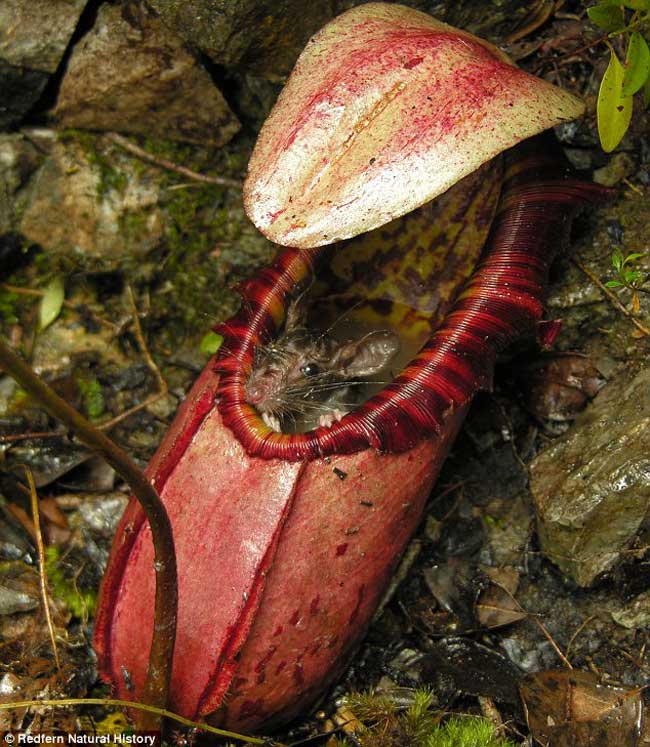Plants are the second most ranging species in the world. They provide many benefits to the Earth’s ecosystem from releasing oxygen to cleaning water, all living things need plants to survive.
They are earth’s natural ornaments, decorating the forests and jungles, providing homes for many animals.
With plants ranging in shapes, sizes, and colors, some look like they could have been taken out of the mind of a sci-fi writer. Characteristics from carnivorous diets to foul smelling flowers to unconventional ways of pollination, some of these plants seem to be from out of this world!
Out of over 390,900 species identified by scientists, here is a list of three of the most unbelievable plants in the world.
 1. Corpse Flower
1. Corpse Flower
The plant, known by Titan arum, Amorphophallus titanum, but most commonly, the corpse flower, is one of the largest and rarest flowering structures in the world.
Instead of a single flower, the corpse flower is technically made up of a cluster of flowers which can span over 10 feet. This plant only blooms once in its lifetime, which ranges from four to ten years.
While in bloom, this flower emits a smell resembling that of a dead animal. It has also been compared to the smell of rotting meat or a decaying corpse, resulting in its namesake. The blooming period however is very short-lived, opening for less than a day before collapsing.
The reason for the nauctious smell of this flower is to attract bugs, such as dung beetles, flies, and other carnivorous insects. The plant’s burgundy color is also meant to resemble that of a dead animal.
The corpse flower is thermogenic meaning it can warm up to 98 degrees to attract pollinators. After drawing them in, the carnivorous insects go looking for food to no avail.
When they depart from the flowers, their legs are now covered in pollen. This process ensures the continued pollination of the corpse flower.
 2. Death Apple Tree
2. Death Apple Tree
The Death Apple Tree, named the manzanilla de la muerte by Spanish conquistadors, is the most dangerous tree in the world.
Travelers can easily find this tree at sandy beaches and mangroves in tropical climates from Florida down to the Caribbean and even in parts of Central and South America. The reddish-gray bark is often accompanied by a red X, or a red band around the base of the tree, painted by locals who know of this tree’s dangers.
While there have been no reported deaths in modern botanical literature, historians have found evidence that indiginous people would use the tree’s sap to poison their arrows and contaminate the water supplies of Spanish invaders.
Just because the tree won’t kill you, doesn’t mean it won’t cause a world of hurt. Some of the symptoms caused by ingesting this tree’s apples are an intense burning sensation as well as severe swelling of the throat. These symptoms worsen over the next couple hours, becoming excruciating, then slowly subside after around 8 hours.
Along with the painful taste, the area around your mouth will become inflamed and has a strong possibility of blistering.
Touching the leaves of the death apple tree can cause blistering lesions on the skin. This effect can also occur if you are under the tree in a rainstorm, as the dripping water can transfer the tree’s toxins.
Unfortunately, these aren’t the only dangers of this tree. Burning the tree’s wood can release smoke that causes temporary blindness if it gets in the eyes. Getting sap in your eyes will also have the same effect.
 3. Rat-eating pitcher plant
3. Rat-eating pitcher plant
Last, but certainly not least, is the world’s largest carnivorous plant. While there are around 630 species of pitcher plants, this one reaches the largest stretching 4.9 feet tall with a width of 11.8 inches in diameter.
Other names for this plant are, Nepenthes rajah or Nepenthes attenboroughii, after the famous naturalist, David Attenborough, who was a keen enthusiast of the genus.
The rat-eating pitcher plant was discovered on Mount Victoria in the Philippines. While most pitcher plants eat small prey like spiders and insects, this particular species is a vertebrate specialist. Thus meaning the plant’s diet consists of rodents, birds, amphibians, even some reptiles.
With the smell of lavender and sweet nectar, rats are lured to this plant. When the rodent leans over to drink it, it slips down the waxy interior of the plant, getting stuck in the sap at the bottom.
Once trapped, the plant’s acid-like digestive enzymes are activated and break down the plant’s prey.
I really like the way you’ve organized your blog, it’s very crisp and clear yet still aesthetic and purposeful. I also really like how each of your posts are clear and have a clear purpose. I also love how you include pictures, with your topic it really makes sense to include photos, great job:)
I really liked your blog post, I was super interested! The way you organized it was perfect and easy to follow!
The rat pitcher plant needs to be in NYC, but this was super interesting to read about. Very well organized as well.